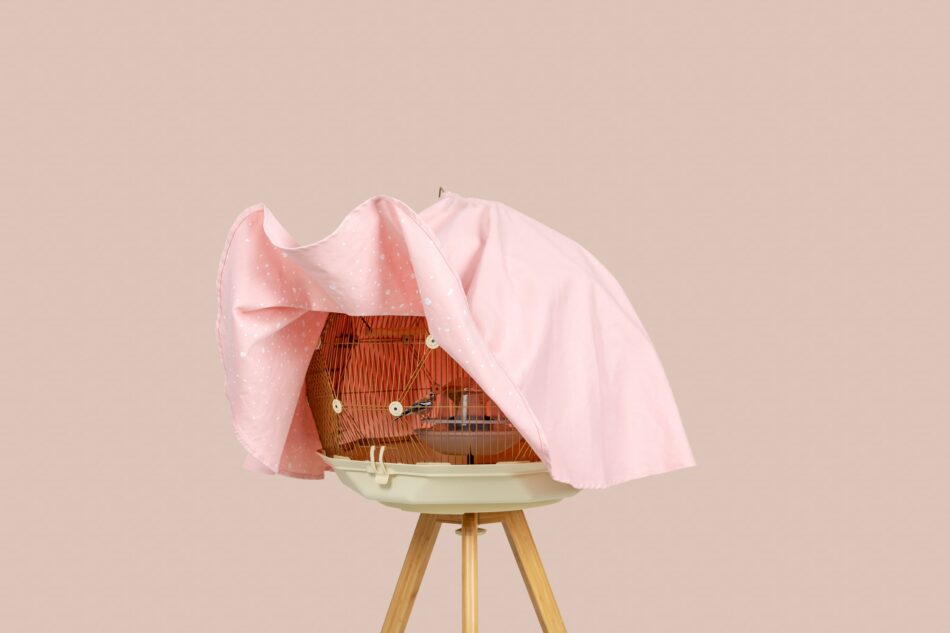
Looking to refresh your parakeet’s home this spring? The warmer weather, longer days, and budding flora and fauna often inspire families to declutter, organize, and spruce up their homes. And, as part of the family, you can include your parakeet in your home improvements. While pet birds benefit from a tidy, well-planned environment year-round, Omlet can help you refresh your parakeet’s home along with your own.
New season, new home
After being pent-up all winter, we all want to stretch our metaphorical wings – and your bird will be ready to stretch their literal ones. The Omlet Geo Bird Cage offers 44% more space than traditional small bird cage designs, giving your parakeet ample space to take flight.
Our artfully designed small bird cage takes an elegant approach when it comes to displaying your parakeet. The unique design not only allows more space, but was created to look great in any room. Use additional small bird perches that add character to your bird’s home, and choose from different wire and base colors to match your home’s aesthetic.
But it’s not just for looks – the Geo Bird Cage was also designed for practicality. We’ve created this low-maintenance cage to be easy for you to clean, and to prevent accidental messes from your small feathered friends. The Geo’s thoughtfully centrally located feeder and waterer has been thoughtfully designed to reduce spills and waste. An optional solid bamboo stand can elevate your Geo Bird Cage to new heights – offering new vantage and focal points for both your bird and your room.
Try cage covers
Give your bird their beauty rest when you add an optional cover. Parakeets sleep best when it’s dark, but spring brings more daylight hours that can interrupt their sleep schedules. Since they’re diurnal (meaning they sleep at night and are active during the day) and need 10-12 hours of sleep each night, a cage cover can help coax them into slumber even when it’s still light out.
Specifically designed to fit the Geo cage, our Geo Bird Cage Night Cover in blossom pink is the perfect color for a seasonal spring palette. Or, try our Geo Bird Cage Cover in midnight blue for a darker hue if that’s more in line with your style. Both colors allow for more restful sleep by providing cage coverage from the top down, while keeping the bottom open and airy for proper ventilation.
Add new cage accessories
Birds are highly intelligent creatures, and your parakeets are no exception. And, as with all intelligent animals, parakeets thrive in an enriching environment. Investing in new toys is a great way to keep your bird’s cage fresh and engaging. Omlet’s Geo Bird Cage Accessories add flair and fascination to your bird’s enclosure, offering hours of boredom-busting activities.
Keep your birds healthy and happy by providing them with an enclosure that fosters their natural behaviors. Spruce up your parakeet’s space this spring with mirrors and perches to stimulate their critical thinking and add variety to their routine. Or, add a bird bath to appeal to your bird’s love of bathing.
Refresh your bird’s home with a spring clean
For optimal cleanliness, you’ll want to deep-clean your bird’s cage at least once a week. But, if you have more than one bird, you may find yourself needing to clean their cage more often. Thankfully, the Geo Bird Cage is easy to clean in minutes – letting you spend more time with your birds and less time cleaning up after them.
Our included feeder has an enclosed base to catch seeds that are dropped during feeding, reducing the amount of wasted seed littering the bottom of the cage. The bottom itself is easily removed and can be hand washed or sprayed with a bird-safe sanitizing solution and wiped clean. Optional paper liners make cleaning even faster – simply remove the paper lining and replace with a new one for a quick and easy clean in between deep cleans.
Entering a new season with Omlet
Maybe you’re a seasoned parakeet owner, or are considering welcoming one into your family this season. Spring brings lots of changes, and is the perfect time to switch up your bird’s routine or to embark on a new bird-owning journey. From products to help your birds catch more shut-eye during the longer days, to cages that make bird ownership easier and more enjoyable than ever, Omlet has what you need to deepen the bond between you and your bird. See why thousands of people choose Omlet for their pet’s needs, and share in the wonder that our products bring to pets and their families.
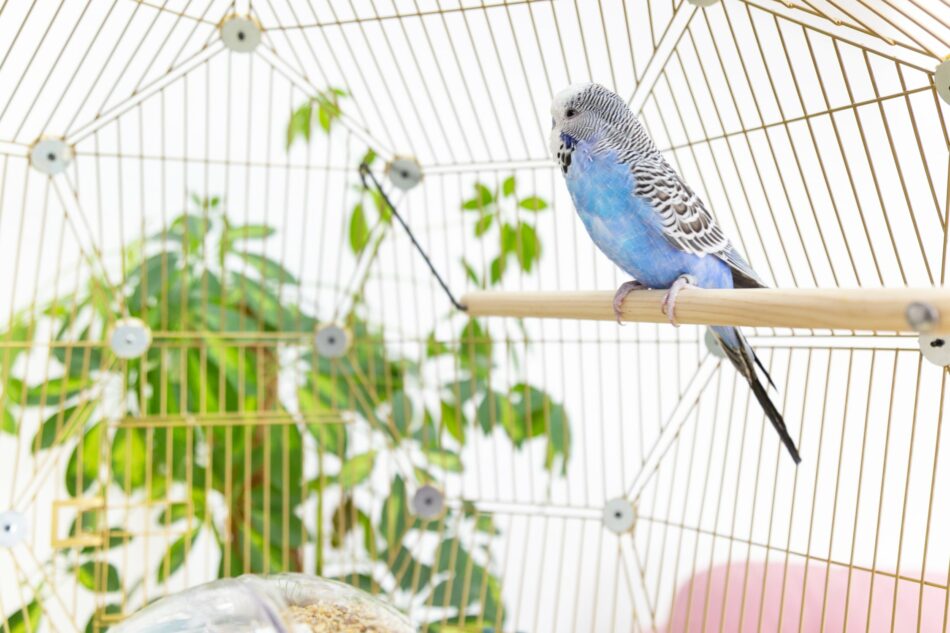
This entry was posted in Birds
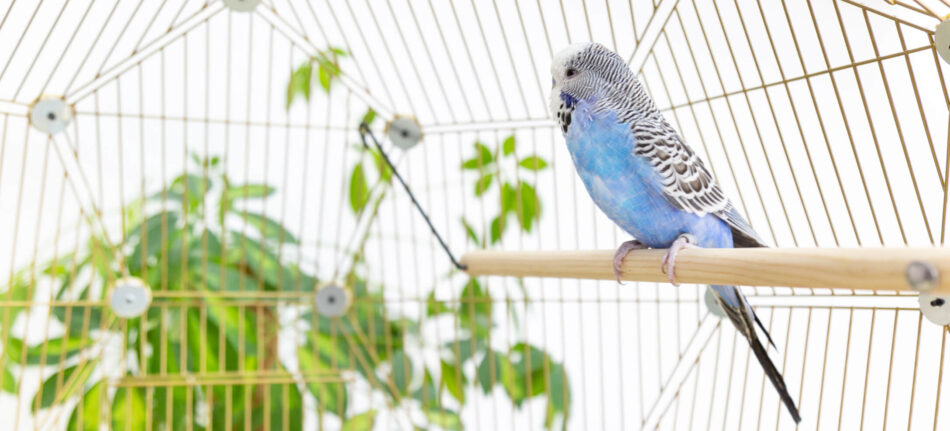
Budgies are highly intelligent, relatively low maintenance, and are renowned for their hilarious personalities! And with their beautiful, striking appearance too, it’s hardly surprising that budgies are the world’s most popular pet bird. As with any pet, building a good relationship between you and your feathered friend can take time, so ensuring your budgie feels safe and comfortable around you is key to building a long-lasting friendship. So, you may now be asking the question of how to get my parakeet or budgie to like me?
Step 1 – Make Sure They’re Comfortable
The first step to getting your budgie to like you is to make sure that they’re comfortable in your presence and their environment. Providing them with a safe and secure cage is a great place to start. The Omlet Geo Bird Cage is the perfect space for budgies, with a geodesic, spacious design, offering plenty of room for perching and flying! Furthermore, the Omlet Geo Bird Cage has a choice of Omlet Geo Bird Cage Night Covers to choose from, that not only look great but most importantly, help to protect your bird from any loud noises and provide them with a feeling of security at night when you are not there.
Maintaining your bird’s space is another important step to take to make your budgie feel comfortable. Just as we wouldn’t feel happy in an unclean, cluttered environment, unsurprisingly nor do our pets. Fortunately, the Omlet Geo Bird Cage is incredibly practical and easy to clean. With a no-spill feeder that catches food and a wipe clean plastic base, your budgie’s cage will remain in top condition with very little work from you!
Once your bird feels settled and comfortable in its home, you should begin to make them feel comfortable in your presence. It’s important not to forget that parakeets/budgies are prey animals, so can be on high alert until they have perceived that you are not a threat.
You should begin by sitting down by their cage, making sure not to make any sudden noises that could potentially scare your bird. Talk to them in a quiet voice, gently repeating their name and introducing them to everyone in the household. You can also perhaps read them a book (even if it makes you feel a bit silly!). Patience is key here, but your budgie getting comfortable around you is the beginning of creating a beautiful bond.
Step 2 – Start to Bond with Them
Once your bird feels comfortable and settled in their home, you can begin to strengthen your bond with them. Generally speaking, it will only take around two weeks for a budgie to become used to their home, although bonding with your bird could take months. Don’t let that put you off though, as since these brainy birds all come with their own personalities, bonding time really does vary from bird to bird.
When talking to your budgie, you can provide them with bird treats at the same time to start bonding. If you notice that your budgie is fearful of your hands, you’ll find it helpful to do some hand training, which we’ll learn about later. Alternatively, you can also place a bird treat holder in their cage for them to enjoy. Not only will a treat holder keep your bird entertained, it will also help to create a positive association with being in their cage. Being present during this time will also help show your budgie affection. After the initial getting to know each other phase, budgies tend to really love their owners, so you can be assured that your affection doesn’t go unreciprocated. Just be mindful that budgies should only be fed occasional treats, alongside a balanced diet of good-quality seed, fruit and greens, and a mineral supplement block.
While parakeets are relatively low maintenance, you’ll still need to dedicate enough time to them to develop your desired bond. Ideally, parakeets need at least an hour of your time, spent solely focusing on them and their needs. This doesn’t necessarily mean that you have to be with them for an hour in one sitting, so you can split this up into short sessions where you can provide your bird with your direct attention. During this time, continue to talk to them before starting to play.
Step 3 – Start to Play with Them
Playing with your budgie is the next step to getting them to like you. You’ll be able to notice when your budgie is becoming more comfortable around you from their body language, which will let you know that they’re starting to trust you and are feeling content. A happy budgie will have a relaxed posture and slightly open wings. You may also notice your budgie bobbing their head, or even their entire body. A comfortable and happy budgie will also let you know how they’re feeling with their vocalizations. If your budgie is chirping and chattering away, then this is another indicator that you have a happy bird on your hands! Read more about keeping your budgie happy on our 5 Ways to Keep Your Birds Happy and Healthy blog!
Budgie toys are great for providing birds with the physical and mental stimulation they require. To initiate play with your bird, it’s a good idea to get a selection of budgie toys to see which they enjoy best.
A firm favorite amongst a lot of birds, however, is the mirror game. It’s the perfect interactive game that both you and your pet can get involved in and only requires, you guessed it… a small mirror! All you have to do is simply hold a mirror in front of your parakeet, to begin with. As your budgie moves closer to the mirror, switch the mirror to face another direction, until your budgie eventually ends up chasing their reflection! Alternatively, using a parakeet mirror in their cage will keep them entertained, even when you’re not around.

Step 4 – Handle them Gently
Now that you’ve started to build a bond with your bird, you may wish to start handling them. Before doing so, along with of course talking to and providing your budgie with toys and treats, raise your hand to your budgie’s cage. Within a few days, your hand will also become familiar to your bird, which is the first step towards handling them.
Now it’s time to put your hand inside the cage. Most importantly here is to not make any sudden movements to potentially frighten your bird. While remaining calm is essential when first having physical contact with your budgie, you should be confident in your approach. Slowly placing your hand inside the cage should get your bird familiar with being close to you, before they are fully comfortable with sitting on your finger. You should keep your hand in your budgie’s cage for five minutes at a time and practice this during your sessions with your budgie throughout the day. Use millet on your finger, so that your bird will eventually get used to having to go between your thumb and index finger to get their reward.
It is important to point out that your bird may initially peck at your fingers when you reach for them. Although this won’t be hard enough to draw any blood, it’s worth noting. As a whole, however, budgies are rarely aggressive by nature, and if anything, they may clash with each other over food and territory, but this temper is often short-lived.
Step 5 – Start to Train Them with Commands
Tricks may look impressive, but they’re also fantastic for helping to build up a lasting bond between you and your parakeet!
One of the first commands you can teach your bird is to hop on and off your finger, also known as finger training, as we briefly touched on earlier. Once your budgie has this initial move down, you’ll be able to move on a few more complicated tricks! However, to finger train your budgie they’ll need to be confident around your hands, as you would have been practicing with step 4 hand training.
After your budgie has eventually perched on your finger with your hand in their cage, you can begin using “step up” and “step down” commands, as they move on and off your finger. Repetition is important, so be consistent with the commands you’re using and reward your budgie when they successfully follow what you’re asking of them. Soon enough, with a bit of patience, your bird should be able to hop on and off your finger when offered it as you open their cage.
As your bird advances, you can spend some more one on one time with them and teach them some more basic commands with a few short sessions. Read our previous blog Four Easy Tricks to Teach your Parakeet and our Teaching Parakeets Tricks guide for a bit more inspiration!
Step 6 – Tame Your Parakeet
If you followed all of the steps above, you should’ve been able to tame your parakeet. This is all about having your bird’s trust, which would have been built over several training sessions and time spent together. At this point, you can practice letting your budgie out of their cage to roam free. They may initially again need treats and encouragement to entice them out of their comfort zone, so continue to use a soothing tone you’ve used throughout the process to help them. If they immediately fly back into their cage, it’s nothing to be concerned about. As with every step of bird training, patience is key!

So, now you’ve got a tame bird and have created a wonderful, affectionate bond, you’ve got years of great fun ahead. Even after your bird is tamed, you should continue to spend time with them, so that they can live a fulfilled life as the happy, sociable animals they are meant to be!
This entry was posted in Birds
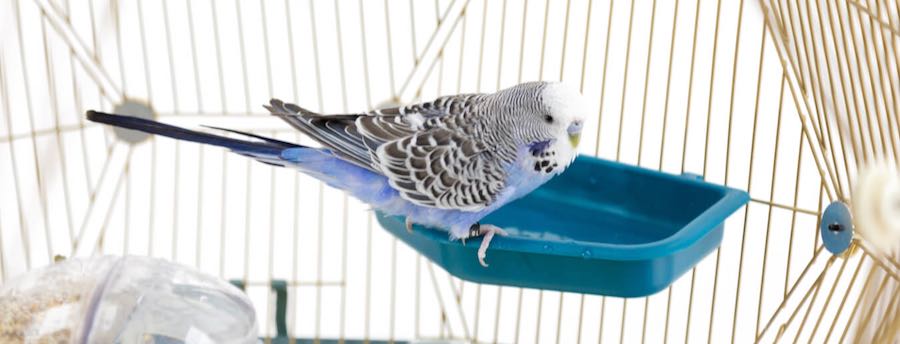
It’s a dusty business being a pet bird, in a world of sawdust, seed husks and the dry atmosphere of the great indoors. The dust gets lodged at the base of the feathers, and the skin starts to get itchy. This is why most birds absolutely love taking a wet bath.
This doesn’t apply to all species, though. Every chicken keeper knows how much their hens love a good dust bath – making things drier and dustier than ever. You may also notice wild birds such as blackbirds and sparrows dustbathing too.
Many birds happily mix and match these two different bathing techniques. But in general, it is thought that the preference for one method over the other depends on where the birds originate. Land-based birds with access to water tend to bathe in it, while those in more arid habitats favor dustbathing. The dust helps maintain the correct oil balance on the bird’s feathers, and also deters parasites such as lice.
When a bird mixes and matches, it is both cleaning itself (with the water) and then de-lousing (with the dust).
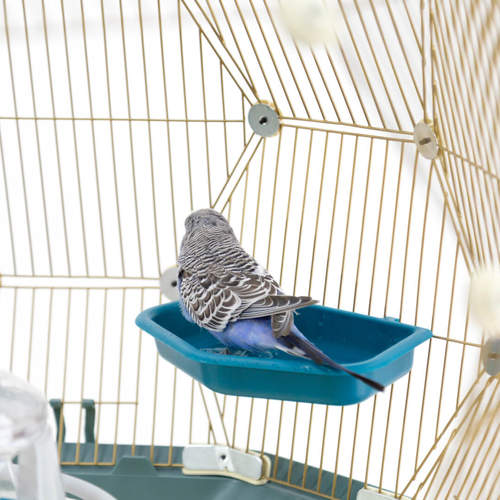 Bird Baths
Bird Baths
During hot weather, budgies may take a dip several times a day, given the chance. Their bath can be fixed inside the cage or can simply be a shallow bowl on the ground outside the cage. Keeping the bath external to the cage helps keep things dry and tidy. There’s a lot of flapping and splashing involved in bathing if you’re all hot and bothered and covered in feathers!
The bath serves at least three purposes. It helps the birds get clean; it helps them cool off; and it provides a lot of fun. Some birds can’t get enough of it; and yet some owners report that their bird baths are never used. This lack of appeal is a bit of a mystery. Given the chance, most budgies relish the chance to splash around, and will use their drinking water as a mini bath, if possible. Some, however, never get the bath bug. This is probably due to early exposure – if a bird hasn’t been given the opportunity to enjoy a soak during its first nine months, it may never acquire the taste.
An unbathed bird isn’t a problem – the budgie will still preen and ruffle its feathers to clean itself of dust, and it certainly won’t become smelly.
Budgies – most of them – also enjoy what is known as a ‘bird shower’: bunches of edible greens and herbs freshly dipped in water. These act like a budgie carwash, and the bird will enjoy rubbing and rolling in the moisture before shaking itself dry – and probably taking a bite or two from the shower to round things off!
Finch Baths
Everything that applies to budgie baths applies to finch baths too. Always make sure the ‘bathtub’ is secure – either fixed to the cage, or broad-bottomed so that it cannot be tipped over. Finches tend to be a bit nervous, and a wobbly bath will shake their confidence.
Some species, notably the canary, also love a spray-shower. Tepid-to-lukewarm water in a mister-spray is their version of a luxury spa session. Once your bird is hand-tamed, introduce the spray and see how the finch reacts. If it becomes scared, don’t continue, but try again later. In 90% of cases, your pet will come to love this form of pampering.
Parrot Baths
Like budgies, most larger parrots enjoy the opportunity to bathe. The water is thought to fulfil several different purposes, from cleaning the feathers and softening up dried-on dirt for easier removal, to assisting molting and helping the respiratory system.
Many parrots enjoy the spray-mist shower too, and some of the large species even acquire the taste for joining their owners in the shower room! This is not without its hazards, though. Parrots’ respiratory systems are sensitive to chemicals found in tap water, such as chlorine and fluorine. If your parrot is to be your shower companion, you will need to fit a shower filter that removes these chemicals
A wide dish is a more conventional bath for a parrot, though. The birds will use the dish for drinking as well as bathing, but that’s fine.
General Bird Bath Rules
Whatever type of birds you keep, their bath will become dirty very quickly, and the water will need replacing at least once a day. Many owners impose bath time on their birds, only introducing the water at certain times. In smaller cage set ups this is the best method, as it avoids everything getting very wet very quickly, and staying that way.
In a larger aviary, the bath is usually installed as a permanent cage feature. It’s always interesting to see which of the birds become ‘bath addicts’, and which ones prefer a quick preen-and-shake, no water required!
Whatever your set up, always make sure the water is at room (or ambient air) temperature. Allow cold tap water to cool first – a bird that takes a cold dip may suffer shock to the system and become ill.
Above all, bath time is fun – both for the bird, and as a spectator sport!
This entry was posted in Birds

Whether you’re buying a present for an animal loving child or for your own little pet, we’ve got the perfect gifts, big and small. Check out these top tips, now at an amazing price in the Omlet Black Friday Sale!
Shelters and Play Tunnels
Give your rabbits or guinea pigs something fun to play with on their run this winter with Zippi Shelters and Play Tunnels. Available in green or purple, the shelters are a great way of providing a safe and secluded place for your pets to hide, or as a platform they can jump onto and watch the world go by.
The play tunnels can be placed independently anywhere on the run for your pets to chase each other through, or be connected to the shelters to create a maze that mimics their wild burrows. Entertainment and safe spot all in one!
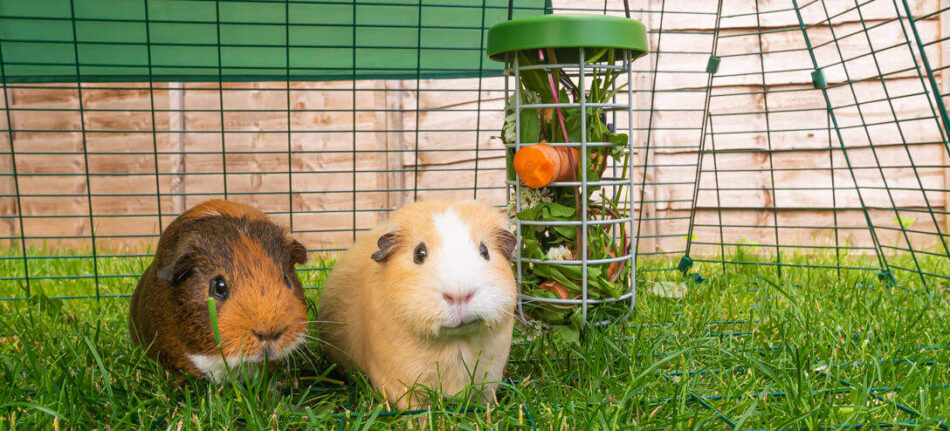
Caddi
The Caddi Treat Holder is the perfect stocking stuffer for chickens, rabbits or guinea pigs, or their owners. The Caddi can be filled with a range of pet appropriate treats, and will swing as the animals peck or bite the treats. It’s the ideal both mental and physical challenge, with the added bonus of a tasty reward!
Hung from the roof of your hutch and run, the height of the Caddi can easily be adjusted, and it’s super easy to remove it for refilling and cleaning.
Qute Hamster and Gerbil Cage
The Qute allows hamster and gerbil owners to get closer to their pets. The modern design means you will be happy to display the piece in your kitchen or living room, and the large, crystal clear bedding tray makes it easy for pet owners of all ages to see what their pets are up to. The bedding tray also offers a convenient way of getting your hamster or gerbils out of the cage for playing, socializing and exercise.
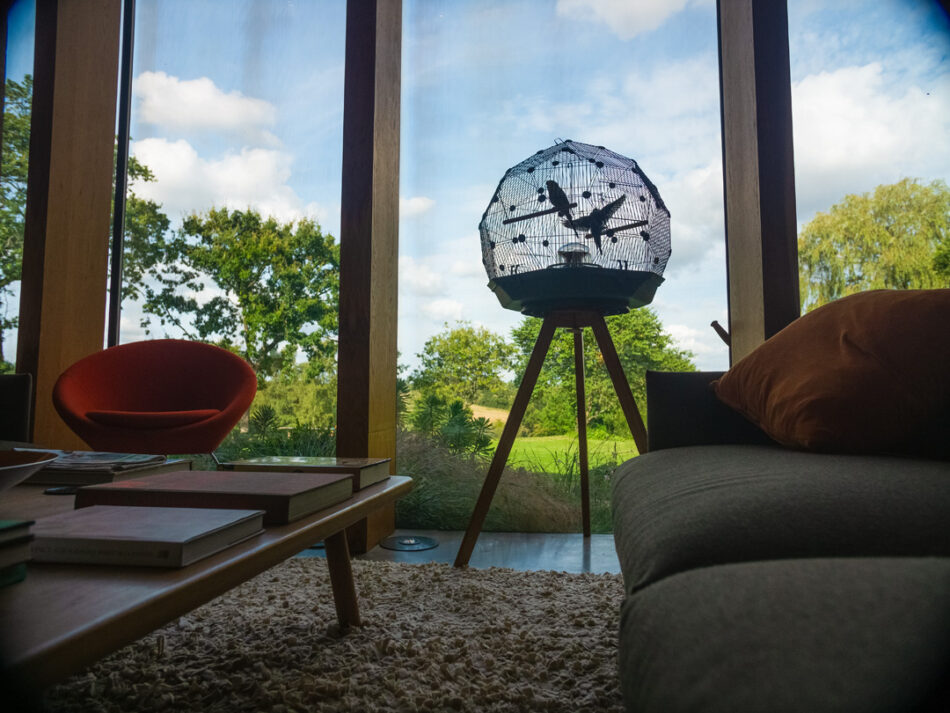
Geo Bird Cage
Upgrade your parakeet/budgie or other small birds’ home this winter with the stunning Geo Bird Cage. The Geo has got everything your bird needs to become a natural part of the home, and you can accessorize with baths, mirrors and toys for your pets to enjoy.
Eglu Go Hutch
Do your current pets need a home improvement? The Eglu Go Hutch is the perfect way of keeping rabbits or guinea pigs in the garden. The handy integrated hutch and run solution allows your pets to run in and out as and when they like during the day, and when it’s time for a nap they can curl up in the safe and insulated house. In winter you can move the hutch closer to the house, making cleaning and spending time with your pets even easier.
This entry was posted in Birds
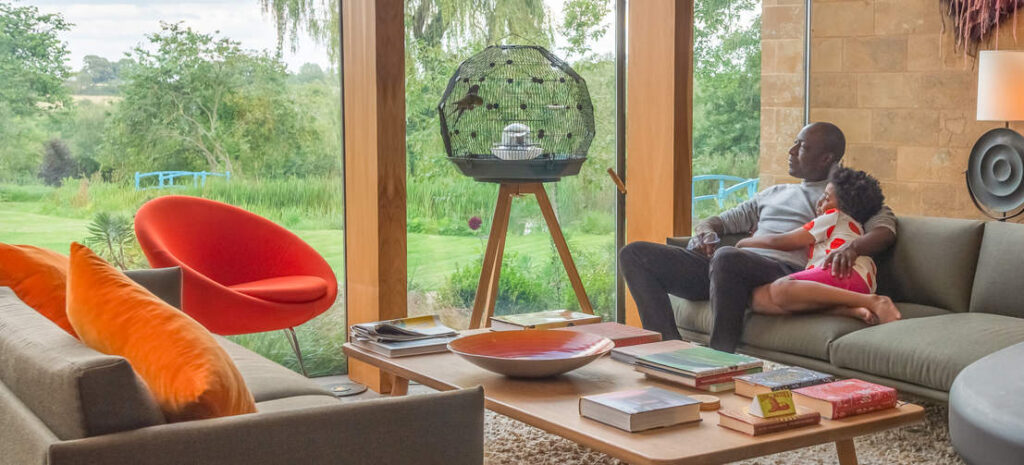

OFFER NOW EXPIRED
Double savings? Yes, please!
Terms and conditions
This promotion of 10% off and free delivery on the Geo Bird Cage and Accessories is available until 30th September 2021. Use promo code GOGEO at checkout to get 10% off and free delivery on the Geo Bird Cage, full height stand, covers, mirrors and baths. Excludes low height stand, perches and paper liners. Subject to availability. Free delivery only applies to the included products, delivery charges will be added for other items added to the order. Free delivery offer is not redeemable on pallet deliveries. Omlet cannot take responsibility for third party supplier delays such as courier service. Free delivery is only valid for orders sent to mainland US, and only applies to Standard Delivery Service. Omlet ltd. reserves the right to withdraw the offer at any point. Offer cannot be used on existing discounts or in conjunction with any other offer.
This entry was posted in Birds

Some animals, such as rabbits and guinea pigs, are herbivores. Others, like hamsters, are omnivorous. Finally, there are also carnivores like cats that cannot survive without meat.
All animals need to have their nutritional needs satisfied. However, this does not mean you can’t have a vegan dog. Vegan cats, though, are a lot trickier.
Can my dog have a vegan diet?
 If you were to meet a species of animal for the first time and had to make an accurate guess about its diet, you would get lots of clues by looking at its teeth. The teeth of a dog, like the teeth of a bear, proclaim loud and clear that this animal is an omnivore – that is, one that eats both meat and vegetables. If you think of your dog as a domesticated wolf, you get a good idea of its natural diet.
If you were to meet a species of animal for the first time and had to make an accurate guess about its diet, you would get lots of clues by looking at its teeth. The teeth of a dog, like the teeth of a bear, proclaim loud and clear that this animal is an omnivore – that is, one that eats both meat and vegetables. If you think of your dog as a domesticated wolf, you get a good idea of its natural diet.
However, as the panda proves, a supposed meat-eater can sometimes get by perfectly well on a vegan diet. A panda’s teeth are similar to any other bear’s – long canines for meat-eating and molars for grinding vegetation. And yet pandas don’t eat anything other than bamboo. So, if a bear can be vegan, does that mean you can have a vegan dog?
The answer is yes – but it’s a yes with lots of small print! A dog requires a diet that contains the fats and proteins it would get from meat. It is dangerous to ignore this basic need and simply feed your pet with whatever you please. Some dogs have delicate stomachs. Also, a low-fat/high-fibre diet can cause potentially life-threatening problems. A diet that excludes meat should never be fed to a dog without the advice of a professional pet dietician.
The collagen, elastin and keratin found in meat diets are not easily replaced by veggie equivalents. Your dog will also need the ‘long chain’ omega-3 fats found in animal products such as egg, fish and some meats. Vegan omega-3 fats are not the same as animal-derived ones.
All of which presents a headache for the vegan dog owner. There are, however, products available that claim to let your dog live a healthy, meat-free life. Before you take the plunge, it is essential to seek professional, scientific advice and guidance. Compromise is usually the best choice here – a vegan diet supplemented by some of the animal-derived essentials. Crickets, for example, can provide lots of the amino acids and keratin a vegan diet lacks, and they’re 65% protein.
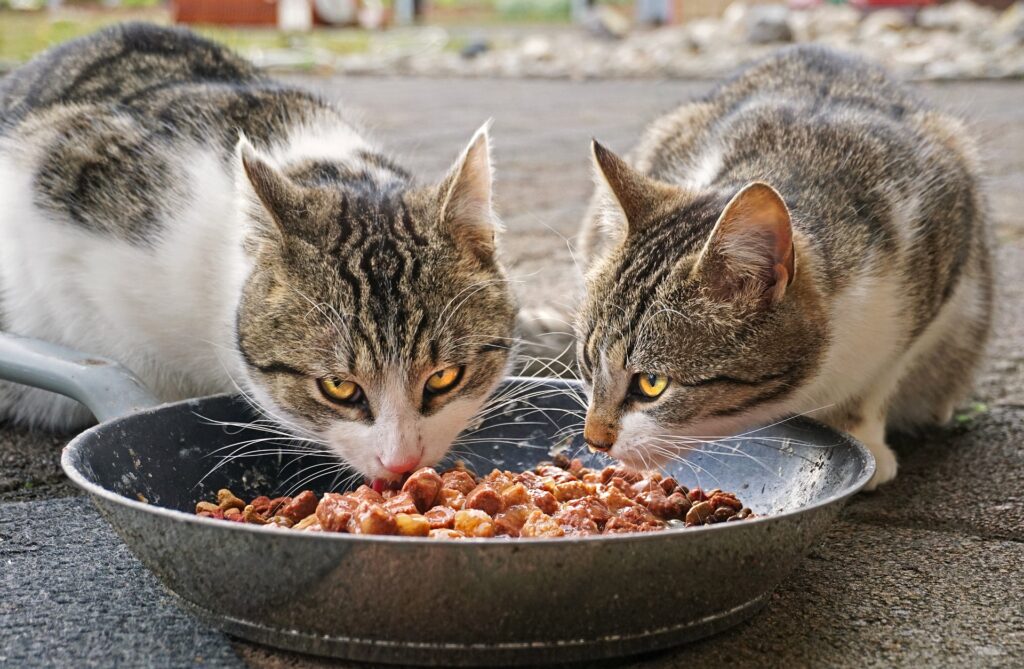
Can my cat have a vegan diet?
The compromise approach is even more important for cats. These are amongst the planet’s true carnivores, obtaining all their dietary requirements from other animals.
The main challenge with minimizing the meat in a cat’s diet is that, unlike many mammals (including dogs), cats cannot produce certain proteins. They have to absorb these from the meat and fish in their diet. Amino acids are another issue – cats deficient in the animal-derived amino acid taurine, for example, usually succumb to a specific type of heart problem.
Even a fortified vegan cat food cannot be confidently recommended. Turn the situation on its head, and try to imagine weaning a rabbit onto a meat-only diet, and you will get some idea of the challenge – and the ethics – involved.
There are some lab-grown ‘meat’ products in development, with vegan and vegetarian cat owners in mind. However, whether these will arrive – and remain – on the market any time soon is hard to guess.
For many vegan pet owners, there is a huge ethical issue involved in feeding the animals they share a space with. Ethics, however, include the animal’s needs too, and it’s an almost impossible issue to resolve when it comes to cats. If you are able to reduce but not eliminate the meat in your cat’s diet, that’s the safer option.
Top 10 pets for vegan households
There are, of course, plenty of other pets that don’t eat meat, or that eat some meat but can still thrive on a meat-free diet. Here are our ten favorites.
 1. Rabbits. No problems here – rabbits are happy vegans, with diets based on hay and vegetables. You could argue that the soft pellets they eject and then eat are animal products of a sort, but they are simply semi-digested vegetation.
1. Rabbits. No problems here – rabbits are happy vegans, with diets based on hay and vegetables. You could argue that the soft pellets they eject and then eat are animal products of a sort, but they are simply semi-digested vegetation.
2. Guinea pigs. Like rabbits, these wonderful little characters thrive on a 100% vegan diet.
3. Hamsters. Most hamster owners give them store food, you don’t always know what’s in it. However, hamsters, like rats and mice, can do without meat.
4. Gerbils. Like hamsters, gerbils are omnivorous. They have sensitive stomachs and need a quality pellet mixture. Too much fresh produce can harm their digestive system.
5. Mice. Although they will eat pretty much anything in the wild, mice can thrive on vegan diets; but it is still best to use a food mix prepared specifically for them. This ensures that they will not be deficient in any of the vitamins and minerals they need.

6. Rats. These are the most omnivorous of rodents, but as long as you feed them a vegan mix that has been fortified with all the nutrients they need, they will thrive. Be careful, rats who eat too much animal fat tend to become fat and die prematurely.
7. Chickens. If you watch a free-range hen, it soon becomes clear that she will eat anything – grass, beetles, worms, and everything in your vegetable patch if you’re not careful! Most chicken feed emulates this mix of plant and animal products. However, it is possible to buy vegan chicken feed, and circumstantial evidence suggests that hens can thrive on it. However, they are likely to produce fewer eggs, and you will not be able to stop them scratching for worms and bugs, no matter how vegan the layers pellets are!
8. Parakeets and parrots. Vegans will have no obstacles to face with budgies and parrots, unless the birds are being bred. Egg-brooding female birds need a protein boost, normally delivered via an egg-based food or cooked meat. Vegan alternatives are available, though.
9. Finches. Many finch species enjoy bugs and mealworms as treats, but these are not an essential part of an adult finch’s diet. These birds thrive on a mixture of seeds and fresh vegetables.
10. One for reptile fans. When you think of pet snakes and lizards, you probably have an image of dead mice or doomed crickets. However, there are a few commonly kept pet reptiles that eat a 100% vegan diet, the most popular being the Green iguana. Getting the balance of vegetables just right is very important for the animal’s health, but meat is certainly something you won’t have to worry about.
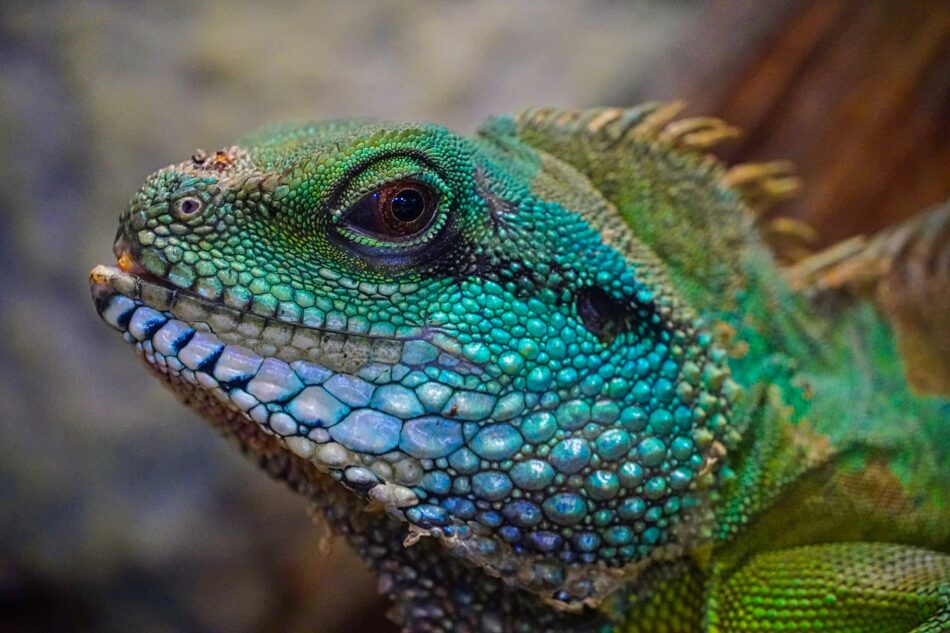
There is no shortage of choice when it comes to vegan pets. Keeping a vegan cat or dog is a much trickier proposition, though. And with all these animals, a balanced diet that matches the pet’s nutritional requirements should be your primary goal.
This entry was posted in Birds

This article is a part of our Pride of Omlet series, a collection of amazing stories which shine the spotlight on extraordinary pets and share their selflessness, bravery, talent and compassion with the world.
-Written by Anneliese Paul
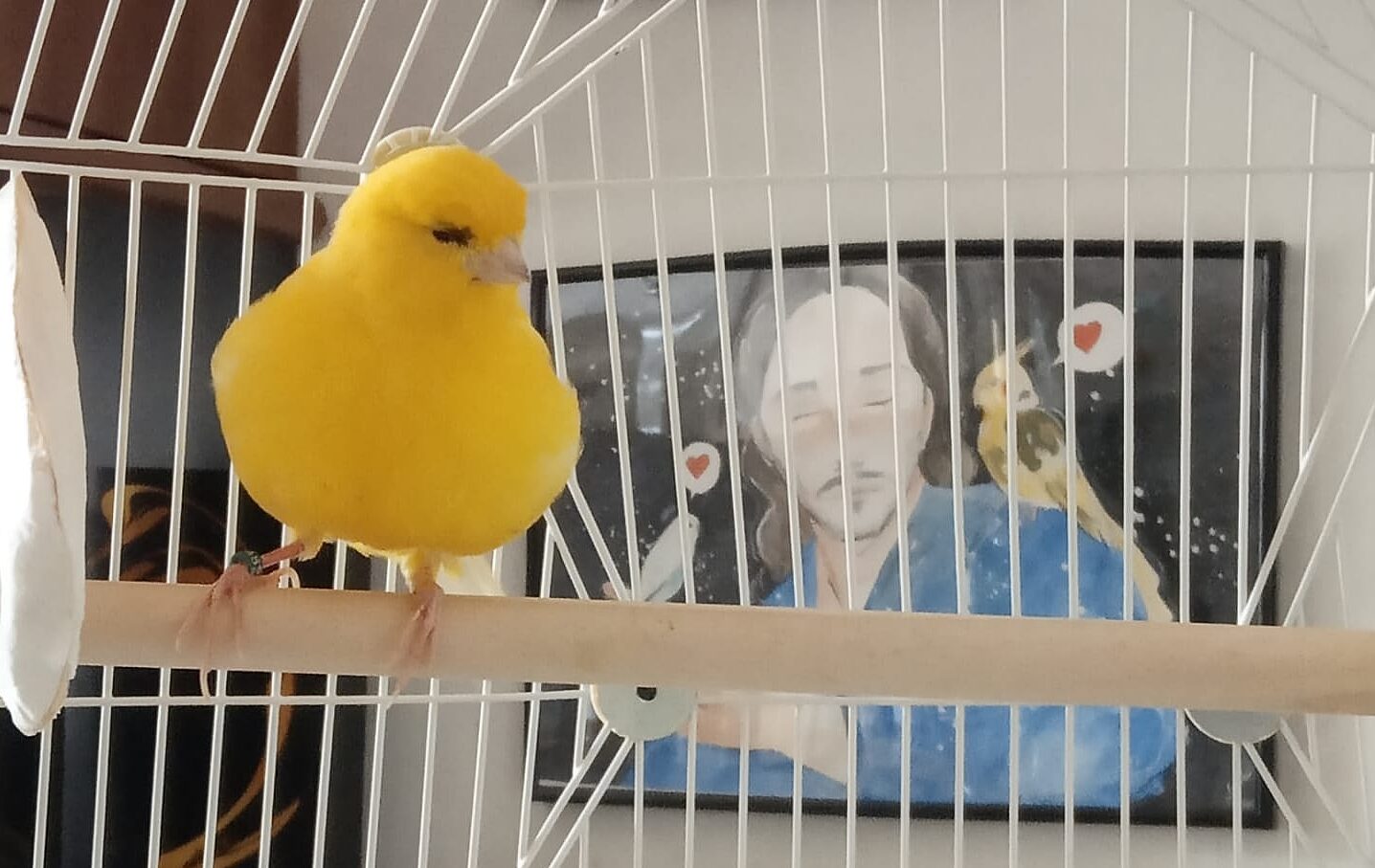
At the tender age of one, Peaky is already a retired filmstar. He had lived in a cage his whole life, released only to perform. When Joana and Fergus took him home, he was a fluffy, yellow bundle of nerves. However, they were determined to help Peaky, their cute little canary companion, to come out of his shell.
When Joana met Fergus, she didn’t know she was falling in love with a human and his pet cockatiel. It had been his best friend for 22 years. Together they grew the flock with a mischievous bird. “He was like a dog; he wanted to sleep with us. You could hold him and kiss him!” But tragically, within a short space of time, the cockatiel died of old age, and then the bird became terminally ill. The house fell silent.

Lockdown 1 without birds was quiet and sad for Joana and Fergus. To cheer themselves up, they decided to get their home ready for another bird and after plenty of research, they agreed on the Omlet Geo as the beautiful new bird home. All they needed now was a bird to live with them.
Fergus works in TV, and if anyone offered an animal, Fergus was known to take it. One day a ray of sunshine arrived on set-a bright little canary owned by a person who supplies animals for TV shows. Fergus struck up a conversation with the owner and learned that this little bird had a feisty character and had to be separated from the other birds, which meant he lived alone, probably in a smaller cage. Seeing Fergus’s enthusiasm, the owner asked, “Do you want this one?”
Ecstatic, Fergus called Joana, “We can get a canary!” When the clapper board shut, Fergus drove Peaky home to Edinburgh. Unfortunately, they got stranded en route in a massive snow blizzard and were stuck in the car for hours before being rescued by locals who took them in for the night. The next day, Peaky and Fergus continued their journey home, and when they finally arrived, the house instantly came alive.
Peaky sings beautifully and chirps up when he hears a running tap, the kettle, the hairdryer, and he even provides backing vocals to Joana’s zoom calls. However, unlike their previous birds, he’s a scared soul that feels safer inside his Omlet Geo.
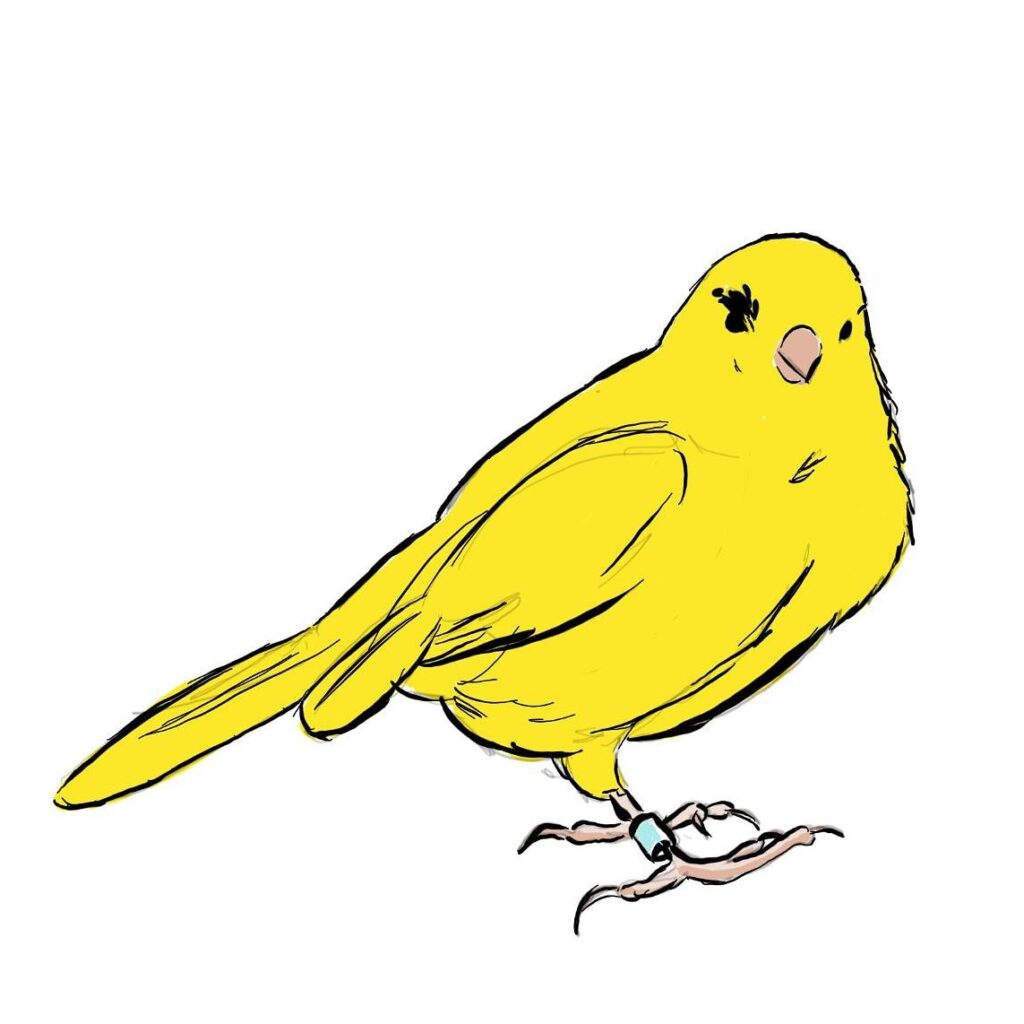
He doesn’t want to come out. Joana understood it would take time to get to know him.
She has a deep empathy with birds and is slowly, patiently, gently, working with Peaky to get him to trust his new human family. When she was younger, she made magazines written from a birds point of view called The Birds Club. Joana is now a professional writer, currently working on a series of children’s novels where birds play the main characters. Peaky even has a little cameo.
He’s getting braver, occasionally eating treats from Joana’s hand, enjoying honey seeds, millet and spinach. Joana makes sure he has space to escape if he’s not comfortable. She doesn’t want him to perform, she just wants to prove to Peaky that he can trust her.
“I’m doing a lot of research to work on rewriting his ideas about us. He came into our lives after being birdless for a year. He has no idea how happy he makes me.”


This entry was posted in Birds
Birds are extremely affectionate pets that love to thrive in a family environment. You don’t need to be a bird expert to keep a small bird under your roof. However, if you want it to thrive and be happy and healthy, there are a few things to consider.
Omlet offers you a list of 5 things to keep in mind when raising a budgie.
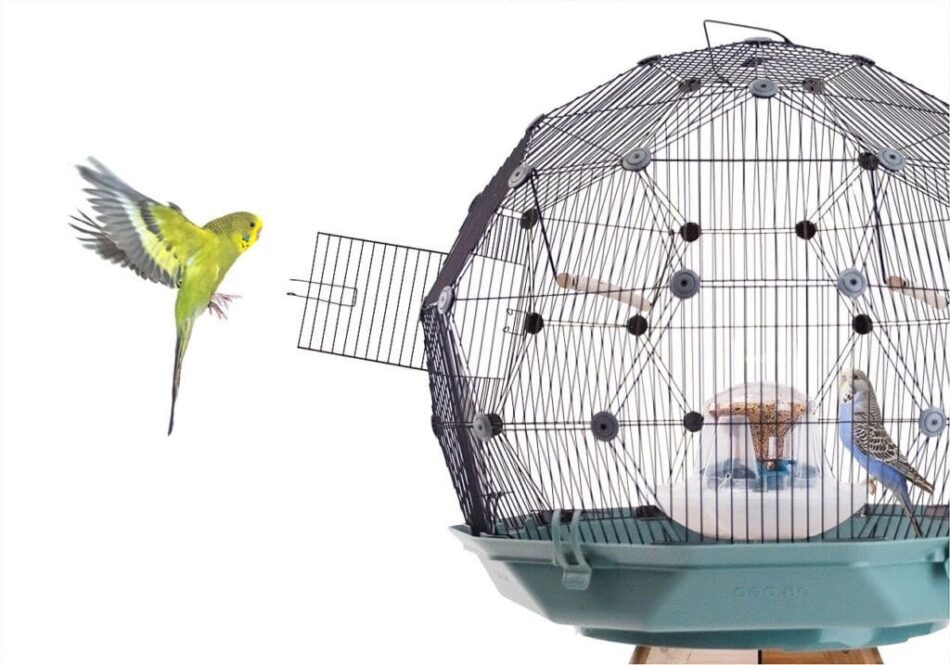
1- Consider investing in a cage that respects your pet and its needs
If you decide to adopt a bird, this should be a priority. Make sure you have a cage that meets your bird’s needs and allows it to be happy. A bird needs enough space to stretch its wings and have fun. Make sure the cage is large enough and that it gets enough sunlight. Your bird will need to see light to be able to thrive.
Budgies fly horizontally and do not fly high, so make sure the cage is wide enough.
It is important to choose a cage that is easy to clean, as you will need to spend time keeping your bird’s area clean. This is essential for your bird’s health (and yours). Budgies need to relieve themselves on a regular basis, approximately every 15 minutes, so you need to have easy access to all areas of the cage so that you can clean the entire cage and avoid unpleasant odors and a dirty environment for your little budgie.
You should also consider a cage that can accommodate several birds. Although birds can be kept alone, they do prefer the company of their own kind.
The Omlet solution: The Geo Cage
The Omlet Geo Cage for Budgies, Finches and Canaries complies with current regulations to provide your pet with the space it needs. Its innovative design provides a safe and airy living space for your budgies. This cage is the result of many years of research to provide your birds with an optimal environment to keep them happy.
This cage not only meets the needs of your budgies but is also functional and can be cleaned quickly and easily. The inside of the cage will be as good as new after your visit. In addition, The Omlet Geo Cage for Budgies, Finches and Canaries offers an exceptional design that allows it to be integrated into any interior decoration.
The cage is extremely important, as is its location. Remember to place the cage in a room with stable temperatures: not too hot, not too cold. Also avoid rooms that are too noisy with too much traffic and activity. Your birds need peace and quiet. A bright room will make your little bird happy. However, avoid placing the cage too close to windows, as the sun through the glass and the intense heat can be dangerous, or even fatal to your pet.
2- Don’t skimp on accessories
Taking care of your bird is not only about giving it a place to sleep, it is also about allowing it to have fun and discover many things through a variety of accessories. The bathtub is not a trivial accessory: budgies love to stay clean. There are many plastic tubs available that allow your bird to clean itself and feel clean all the time. Choose a bathtub that fits your cage and can easily be installed in it. It should be easy to fill from the outside.
At Omlet, we offer a Geo Bird Bath that fits our Geo cage and its sloping sides perfectly.
Technique for the bathtub: do not fill it to the brim, as you will find water everywhere. The tub should not be too small to allow your bird to enjoy it fully, but it should not be too large either, so that it does not take up all the space in the cage. If the bathtub you have chosen fits easily into your bird’s cage, you may want to consider adding it for a few hours while your bird takes a bath and removing it the rest of the time.
You should also consider quality drinkers and feeders that will allow you to feed your beloved animals properly and without hindrance.
If your bird can clean itself and stretch its wings, it is likely to thrive and feel happy. However, it is necessary to keep it occupied with toys.
So think about furnishing its space with useful accessories that entertain your budgie. Vary the shapes, sizes and aspects to offer your pet new experiences.
Perches for birds are extremely important for your birds and play a significant part in ensuring a better lifestyle. Choose perches with a wooden base, such as pine, as plastic fails to offer the proper grip that your bird needs, and can be bad for their feet.
Bird toys have their place in your pet’s cage, but avoid taking up the whole space. It is important to have several types of toys that you can mix up on a weekly basis to give them more variety and keep your bird entertained.
Toys stimulate your pet and prevent your bird from getting bored.

3- A happy bird is a well-fed bird
There are several ways to take care of your bird and the first way is to feed it sufficiently with quality food. What does a bird eat? Your birds’ favorite foods are seeds, vegetables and fruit. Just like other animals, dogs, cats (etc), never give your birds chocolate and caffeine.
It is essential to ensure that the drinker is always full of water to keep your animals properly hydrated. Your birds will know how much water they need but it must be available to them. If the water is not drunk, it is essential that you change it regularly to prevent the growth of bacteria.
4- Birds need quality sleep!
Sleep is essential for your bird. It allows your pet to rest its body and recharge its batteries. Just like human beings, sleep helps reduce stress and promotes your pet’s learning and memory. It is estimated that a budgie can sleep between 10 and 12 hours a day. A happy budgie is one that benefits from this rest time in the best conditions.
It usually prepares for bed half an hour before going to sleep. You can improve the sleeping conditions of your bird by providing an opaque blanket, which does not let light in and ensures that your bird gets the rest it deserves. This solution also allows you to soundproof the cage a little if there is regular activity in the room. It is sufficient to keep the room dark and to let a little light through so that your birds are not injured if they hear a noise that wakes them up. The Omlet Geo Bird Cage Cover offers your birds an ideal solution for a full and restful night’s sleep. It can be placed on any cage and allows your birds to sleep safely.
Establish a routine each night so that your birds feel comfortable and understand when it is time to go to bed. They will feel confident that there is nothing to worry about and will fall asleep peacefully.
However, if you notice that your bird(s) panic when you put the blanket on the cage, don’t persist. Some birds have their own habits and there is no point in insisting on certain accessories. If your bird is happy and can sleep perfectly and peacefully without a cover, that is the main thing.
5- Give your bird lots of love and get it used to its environment
For a bird to be happy and healthy, nothing is more important than the love you give them in a healthy environment adapted to their needs. Never rush your bird and give it time to adapt to any situation, new environment, new toys or accessories…
Don’t hesitate to talk to your bird and make it feel your presence without smothering it. Repeat its name to get it used to the sound and to assimilate it. If there are several of you in the family environment, introduce the members of your family little by little without rushing your pet. No loud noises or big movements. Your friends or family can enjoy your bird, but in a calm and respectful way.
Treats and time with your pet will make your bird happy. Make sure you spend time with your bird. This will strengthen the bond between you. Gaining your pet’s trust is a long-term process. You can use your fingers to tame your pet little by little, for example by moistening them and placing seeds on them. Intrigued and curious, your bird will surely come to you.
Do not hesitate to open the cage from time to time to let your bird fly in the open air in a room. Just remember to avoid bright lights that may attract your bird and end up hurting it (sunlight through a window, for example). If you decide to let your bird fly in your home, be careful with objects that could either break, or hurt your pet. The room should be secure enough to prevent your budgie from ending up in the vet’s office.
An unhappy bird may become aggressive or develop health problems. This can manifest itself in regular pecking or screaming. Your budgie, if unhappy, may be more agitated than usual. If you are sure that you have done all you can to keep him happy and his aggressive behavior persists or you detect abnormal problems, it is time to make an appointment with the vet. In fact, one visit per year to the vet is recommended to check that everything is going well with your pet.
With all these tips and tricks, your bird can be happy and thrive by your side. All you need is patience and the right equipment and accessories for your pet’s needs.

This entry was posted in Birds













 If you were to meet a species of animal for the first time and had to make an accurate guess about its diet, you would get lots of clues by looking at its teeth. The teeth of a dog, like the teeth of a bear, proclaim loud and clear that this animal is an omnivore – that is, one that eats both meat and vegetables. If you think of your dog as a domesticated wolf, you get a good idea of its natural diet.
If you were to meet a species of animal for the first time and had to make an accurate guess about its diet, you would get lots of clues by looking at its teeth. The teeth of a dog, like the teeth of a bear, proclaim loud and clear that this animal is an omnivore – that is, one that eats both meat and vegetables. If you think of your dog as a domesticated wolf, you get a good idea of its natural diet.
 1. Rabbits
1. Rabbits









